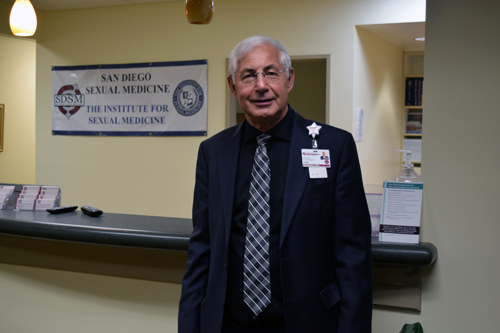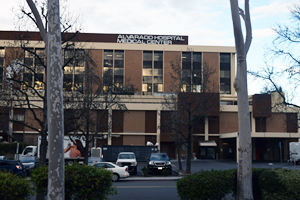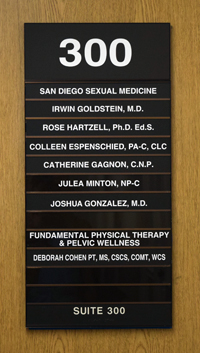
-36th in a Series —
Exit 11: Lake Murray/ 70th Street, San Diego ~ San Diego Institute for Sexual Medicine
By Donald H. Harrison


SAN DIEGO—One might wonder what led to Dr. Irwin Goldstein becoming the head of what is believed to be the first, and perhaps only, hospital-accredited sexual medicine practice in the United States. Was it his undergraduate background in engineering? Or was it the fact that while he was interning in urology, his mentor at University Hospital in Boston, Dr. Robert J. Krane, allowed him to scrub in for a penile implant procedure, which then was a novelty?
Or perhaps it was the fact that an Iranian Jewish acquaintance from his Boston days, Dr. Pedram Salimpour, along with his brother, Pejman, completed the purchase of Alvarado Hospital here in San Diego in 2007 and invited Goldstein to establish the San Diego Sexual Medicine practice in the medical offices next door at 5555 Reservoir Drive, where he could combine his own research with knowledge from numerous fields including urology, gynecology, psychology, pharmacology, and physical therapy.
 Goldstein, whose 5,700-square-foot research center and clinic employs a diverse staff, including his wife Sue as program director, says many of the factors were serendipitous that led him to become a recognized authority in the field of sexual medicine, founding editor of The Journal of Sexual Medicine, and head of the non-profit Institute for Sexual Medicine.
Goldstein, whose 5,700-square-foot research center and clinic employs a diverse staff, including his wife Sue as program director, says many of the factors were serendipitous that led him to become a recognized authority in the field of sexual medicine, founding editor of The Journal of Sexual Medicine, and head of the non-profit Institute for Sexual Medicine.
The doctor had grown up in Montreal, from where he was recruited by Brown University in Providence, Rhode Island, to play college hockey. His major was electrical biomedical engineering, which while fascinating didn’t appear to offer many jobs. So, he related in an interview, he returned to Montreal and enrolled in the medical school at McGill University. Sue, whom he had met and married in Providence, moved to Canada with him. He did an internship in Montreal, followed by a surgical internship and urological residency in Boston.
With his engineering background, Goldstein suggested, “I had a different perspective than 99.9 percent of all the people working with me. Knowing what was wrong was really important versus saying ‘tell me how to manage it and I will manage it.’”
In 1976, his two areas of study—engineering and urology—seemed to come together when Krane asked him to assist on a penile implant. “I had never seen one before,” he recalled. “A penile implant has a series of devices that takes a man who has erectile dysfunction and by the insertion of the implant, he has a rigid penis whenever he would like. I was totally fascinated by the procedure and at the end of the procedure, I said that ‘I have to do this for a living.’”
The amazing thing, continued Goldstein, was that in the 1970s very few people could answer the question “’how does an erection even occur?’ It wasn’t studied; it wasn’t emphasized” yet male erections occurred “obviously quite often. It’s estimated that there are 100 million acts of sexual intercourse every 24-hour period on our planet.” When a penis can’t become or stay erect, “this is called erectile dysfunction, which happens often in aging, yet in 1976 no one knew the physiology of how that worked.”
Assisting Krane, Goldstein learned the field so well that he won a three-year grant from the National Institutes of Health to study erectile dysfunction, and “since then I’ve been doing nothing else. I was in Boston for approaching 35 years, and as time went on I got more and more involved and more and more specialized, and I really wished and wanted to be separate from urology.”
He explained that a sexual medicine clinic needs a “sex therapist, a physical therapist, nurse practitioners, and clinical researchers” in addition to a physician such as himself, and for a department head in the field of urology, these personnel expenditures might seem less important than such other priorities as penile cancer, bleeding, urinary stones and so forth.
Therefore establishing a sexual medicine practice at Alvarado Hospital was “a dream come true,” Goldstein said. Realization of that dream became even more profound when he began instructing classes in sexual medicine at UCSD’s Medical School. Until then, sexual medicine simply was a subject rarely taught to future doctors.
Elsewhere, “doctors don’t get exposure to this; patients are embarrassed and humiliated and just assume that doctors know, but doctors don’t, so it is an uncomfortable condition on both sides of the doctor-patient relationship.”
Dr. Goldstein at first was highly skeptical of the drug sildenafil citrate, later commercialized as Viagra. “I was exposed to it in 1994 as a potential therapy. We didn’t think it was possible that you could take an oral pill” for erectile dysfunction because “70 percent of the penis is muscle and it sits in a contracted state all day until it goes to a relaxation state, in which case (blood can flow into the penis and) you get an erection. So to induce an erection you need what is called a muscle relaxant. In the usual scenario, we were injecting drugs through the skin of the penis into the tissue to achieve this relaxation. Were these drugs to go systemically (throughout the entire body), they would have caused lowering of blood pressure and fainting, and that is not what you want when you are sexually active.”
So back then Goldstein was of the opinion that an oral pill simply would not be practical. But in 1985, sildenafil citrate was administered for patients with angina, and unexpectedly “those patients at night would get morning erections. Then it was good science that asked ‘why did they have the erections?’ The enzyme that this drug blocked was specifically located in the penis. Nobody knew that before. So you could take a pill and although it went everywhere, its effect was more pronounced in the penis where that enzyme was focused. So there is serendipity in science.”
Viagra got people talking and joking about erectile dysfunction, and in 1998, on a Larry King Live television show on which Goldstein also was a guest, former U.S. Senator and GOP Presidential Candidate Bob Dole mentioned, during a discussion, that following his radical surgery for prostate cancer, he too had develop erectile dysfunction which he counteracted with Viagra.
Goldstein said to have a man of such national prominence discuss openly a sexual problem was a fabulous opportunity to enable others. “It was an amazing event. He got hired by Pfizer (the drug company that produces Viagra) and he flew to different places to talk about it. It was pretty eventful.”
As a sexual medicine physician, Goldstein treats both men and women for problems related to healthy sexual intercourse.
“We have something like 26 therapies approved for men, but for women we have only two therapies for sexual pain and one that has been recommended by the FDA Advisory Committee for approval for low desire” Goldstein rued. “We are pre-Viagra in the female world. Hopefully that will change; we have a good chance that will change” with a drug for women.
“The most common female problem is lack of interest,” Goldstein said. “Women sort of do duty sex. They preserve the relationship by having sexual relationships, but they don’t initiate it. They don’t have any desire to have sexual activity. With research we have found that women who have no interest can have that condition for many reasons. There is a subgroup of women who have that condition because of chemical changes in their brain, much like depression is the result of chemical differences in the brain or that Parkinson’s disease involves missing dopamine in the brain. So in that construct, there is a drug out there (now being tested) which has the ability to rearrange the balance and improve sexual function.”
As urologists tended to overlook male sexual dysfunction, said Goldstein, gynecologists often know very little about female sexual problems. He said that when gynecologists do pelvic examinations, they rarely express any interest in the condition of a woman’s clitoris, labia or hymen – or anything about a woman’s external genitalia – but instead will go focus on the cervix and then will examine the ovaries and the uterus.
Besides not being trained to treat women’s sexual dysfunction, another reason for the reluctance of gynecologists may be that “it takes a lot of time” to discuss such matters with patients, “and you don’t yet have any therapies for women that are approved by the government.”
With all the commercials on television about erectile dysfunction or vaginal itching, I asked Dr. Goldstein if he believed people were becoming less embarrassed by discussions of sexual issues.
He responded that cultural influences, including religion, can have a lot to do with just how candid men and women are willing to be about their sexual problems.
For example, he said, he knows of people from the Indian sub-continent where “their society does not believe in premarital sexual activity. The vast majority of them are in relationships that have been arranged, that they have seen each other naked for the first time only on their honeymoon, so it is challenging. How do you have conversations about sex? I have a patient whose wife left him to go back to India because he was impotent. Her family won’t allow her to remain married to him if they can’t have any children. Yet, it is a medical condition. How often would someone say ‘you can’t marry John because he has hyper-tension’? Yet for this medical condition, they say it.”
Jews, in contrast, tend to be more open about sexual issues. Goldstein referred to the concept that marital sex on Shabbat is a special blessing, one which makes both parties closer to God. “This concept of sexual intimacy is not espoused in most other religions and cultures,” he said. “There is a lot of guilt, and grief, concern and worry that someone is watching over you and you are doing something dirty and evil. That is a more traditional view of sex as opposed to embracing it and saying you are closest to God while doing it.”
Our interview concluded with Goldstein offering some general advice for people who have problems enjoying sexual relations.
“I think the best advice that I can give them is ‘go find treatment for it. It is crazy not to do anything about it. I think the vast majority of people who have some sexual dysfunction can break down relationships because they think they can’t do anything about it. There are health providers who can’t help them so they think there is nothing that can be done. I would venture that there is a lot that can be done.”
*
From 70th Street exits, turn north onto Alvarado Road (the frontage street) and turn left at Reservoir Drive.
*
Next: D.Z. Akin’s Deli
Harrison is editor of San Diego Jewish World. You may comment to him at donald.harrison@sdjewishworld.com, or post your comment on this website provided that the rules below are observed.
__________________________________________________________________
Care to comment? We require the following information on any letter for publication: 1) Your full name 2) Your city and state (or country) of residence. Letters lacking such information will be automatically deleted. San Diego Jewish World is intended as a forum for the entire Jewish community, whatever your political leanings. Letters may be posted below provided they are responsive to the article that prompted them, and civil in their tone. Ad hominem attacks against any religion, country, gender, race, sexual orientation, or physical disability will not be considered for publication. There is a limit of one letter per writer on any given day.
__________________________________________________________________